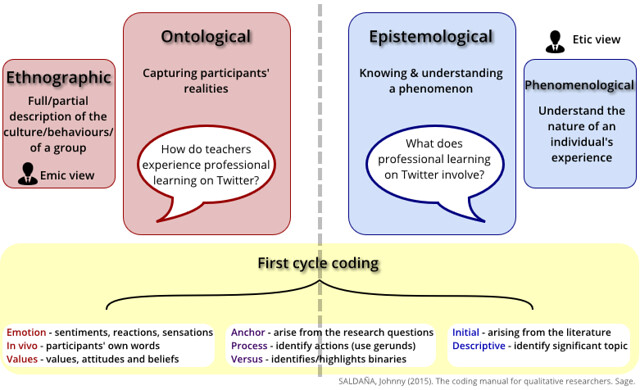Prompted by the NVivo training session a couple of weeks ago, and in preparation for analysing the data from my pilot studies, I’ve been considering what shape my analytical strategy should take. As is often the case when exploring different aspects of your study, it’s important to touch base with your research questions and ensure what you’re considering aligns with your original goals. I discussed previously ways in which my methods maintain alignment; now I need to do the same for my analysis. Would that research life were always that simple … !
I began by revisiting my research questions and immediately began to realise how much my thinking has moved on since writing the research proposal, but of course there’s nothing unusual there.
- How does the Twitter social media platform support the professional learning of teachers?
- What forms of professional learning do teachers undertake using Twitter?
- How does professional learning extend beyond Twitter into the wider social media ecosystem and the ‘real’ world?
- What attitudes and dispositions do teachers need, to use Twitter for their professional learning?
As I look back at these, I feel that the first three are perhaps better served by a more deductive approach. The whole study arose as a result of claims by teachers that Twitter provided them with powerful CPD; my research questions are largely about testing this hypothesis – a deductive approach. What I’m now beginning to see however is that although there is definitely something happening here, whether it constitutes professional learning or professional development, or indeed something else entirely is open to question. That then suggests my approach needs to be more inductive – something is happening and I want to find out what.
I put together the following diagram to illustrate this shift and hopefully to clarify for me where my thinking is now.

I’ve definitely moved left; might one call it an ontological turn? I’m becoming more interested in the reality for teachers as they learn using Twitter and the multiplicity of this ‘thing’ they call CPD. What’s caused this is a combination of what’s emerging in the data, together with my theoretical thinking shifting from actor-network theory more specifically towards a sociomaterial sensibility. I do however have more reading to do here, and need to rephrase my research questions to better reflect this new standpoint.
Lincoln and Guba (1985) claimed that “Not very much can be said about data analysis in advance of the study” and earlier on in my study I was certainly struggling to see what the most appropriate strategy might be. Reading Saldana (2015) provided me with a much more practical handle on what the possibilities might be and which approaches suit which circumstances. In a sense, I found myself having to move several steps forward in order to better understand where I was starting from. The first cycle coding techniques I’m likely to apply to the data in my pilot study will now include those over to the left. Had my thinking not shifted, I’m not sure I’d have considered them, which would consequently have led to rather different findings. As Thorne (2000) observed:
The theoretical lens from which the researcher approaches the phenomenon, the strategies that the researcher uses to collect or construct data, and the understandings that the researcher has about what might count as relevant or important data in answering the research question are all analytic processes that influence the data.
So there are a number of factors which influence the ways the data are collected and subsequently analysed. I need to be aware of them and to document them. That’ll be another blog post (or two) then I guess!
LINCOLN, Yvonna S. and GUBA, E. G. (1985). Naturalistic inquiry. Sage.
SALDAÑA, Johnny (2015). The coding manual for qualitative researchers. Sage.
THORNE, Sally (2000). Data analysis in qualitative research. [online]. Evidence based nursing, 3 (3), 68-70.

[…] this was something I’ve been giving thought to for some while now, although early ideas were very much part of an evolving mix. BY now however, things have firmed up much more and I was […]
LikeLike